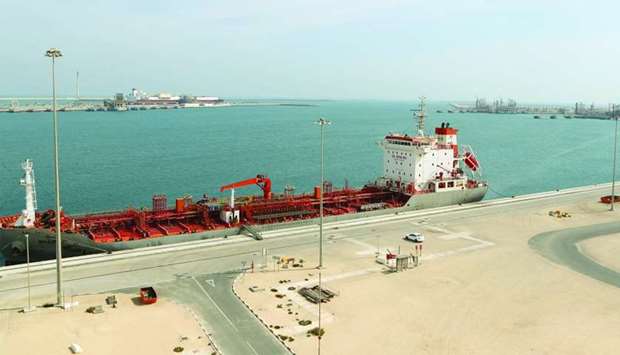*1000 days to 2022 – strides in Qatar's oil and gas sector
Hydrocarbon resource-rich Qatar is well set to make a huge positive impact on global initiatives that seek alternatives to polluting and carbon-intensive fuels.
Qatar is moving forward with implementing its mega projects that will see the country’s liquefied natural gas (LNG) production rise from 77mn tonnes per year to 126mn tonnes per year by 2027.
This will not only enhance Qatar’s ability and flexibility to meet additional demand but also help the shift to less carbon-intensive energy in many parts of the world.
In parallel, Qatar remains focused on achieving the highest environmental standards in its LNG industry to significantly reduce emissions by applying the best available industry technology and carbon dioxide (CO2) sequestration.
The huge production boost by 64% (on the current 77mn tpy) will have a multiplier effect on the national economy over the coming decades and help Qatar consolidate its position as the world’s top transhipper and producer of liquefied natural gas.
Qatar and four other producing countries will lead the growth in liquefied natural gas (LNG) export capacity over the next three decades during which $9.7tn has been earmarked for investment in the gas sector.
Effectively, Qatar’s LNG production capacity will exceed 142mn tpy annually (by 2027), when the output from the Golden Pass LNG export facility located in Sabine Pass, Texas, is also accounted for.
The Golden Pass LNG export project, which is owned by the Golden Pass Products, is a joint venture of QP (70%) and ExxonMobil (30%).
Overall, Qatar’s hydrocarbon production will account for nearly 6.7mn barrels oil equivalent per day with the LNG production capacity boost to 142mn tpy.
The expansion of Qatar’s LNG facilities is considered the world’s largest and one of the energy sector’s most lucrative projects.
The country may also maintain its position as the holder of the largest non-associated gas reserves in the world for the foreseeable future by establishing confirmed gas reserves of 1,760tn cu ft at the North Field.
This is in addition to more than 70bn barrels of condensates, and massive quantities of LPG, ethane, and helium, a huge quantity by any standard.
New studies have revealed that the North Field’s productive layers extend well into Qatari land in Ras Laffan, paving the way for a new LNG production project in the north of Qatar.
Recently, HE the Minister of State for Energy Affairs Saad bin Sherida al-Kaabi highlighted the key role natural gas has to play in addressing the global concerns on environmental pollution and climate change.
At an event in Doha organised by the Gas Exporting Countries Forum, he said, “Natural gas is versatile, flexible, economic and clean. More and more countries are moving away from burning coal and nuclear and are building infrastructure for cleaner alternatives including natural gas.
“I am often asked about renewables and whether we see them as a threat to gas. The answer is 'no'. We believe that natural gas and renewables are complementary. As the cleanest fossil fuel, natural gas comes in handy when the sun is not shining. And when the wind is not blowing.
“Energy from natural gas can be dispatched quickly in a cost efficient and effective manner. I firmly believe the combination of natural gas and renewables offer a reliable, flexible and cost-effective pathway for a lower energy emission system.”
Natural gas will be the only form of hydrocarbons to increase its share during the next 30 years, while fossil fuels will continue to dominate the global energy mix during the period, he said.
“Today, the share of natural gas in the global energy mix stands at about 22%. By 2050, this is expected to rise to 27%, according to the outlook, which is being launched today,” al-Kaabi said.
A few months ago, Qatargas, which is the world’s top LNG producer and exporter, achieved the “best-in-class” reliability performance of 98.8%. The company’s production was also on target in 2019.
Qatargas maintained a “strong environmental and safety performance” as it achieved a flaring rate of 0.38 against a target of 0.44 this year, thanks to a successful flare reduction project whereas the greenhouse gas (GHG) emission rate showed 0.35 against a target of 0.42.
Another major stride made by Qatar last year in the industrial segment (using its vast hydrocarbon resources) was 50 years of production at Qatar Fertiliser Company (Qafco).
Qafco, which celebrated its golden jubilee in 2019, has a total production capacity of 3.8mn tonnes of ammonia and 5.6mn tonnes of urea annually. The fertiliser major has become the largest single-site producer of ammonia and urea in the world through six export-oriented integrated production lines.
The company was the “first building block” of Mesaieed Industrial City, the first Qatari petrochemical manufacturer to export its products from Mesaieed ports to the world, and the first company to train and develop Qatari capabilities to work in and lead the petrochemical sector.
Qafco was also the “cornerstone” of the establishment of Industries Qatar, the largest listed company on the Qatar Stock Exchange. This listing has benefited the national economy.
Early this year, Qatar Petroleum announced the implementation of the ‘In-Country Value Policy’ in the energy sector through ‘Tawteen’, the localisation programme for services and industries in the energy sector.
The ICV Policy will impact the tendering and awarding process, where suppliers and contractors, who are contributing the most to the local economy, will acquire a commercial advantage.
Launched in February, Tawteen received hundreds of applications through its investor portal from local investors and leading global suppliers for about 100 new investment opportunities it offers in various fields, including engineering services, maintenance, repair and overhaul (MRO), digital technologies, subsurface operations, chemicals and metals, as well as light equipment, business services and other services across the energy sector supply chain.


